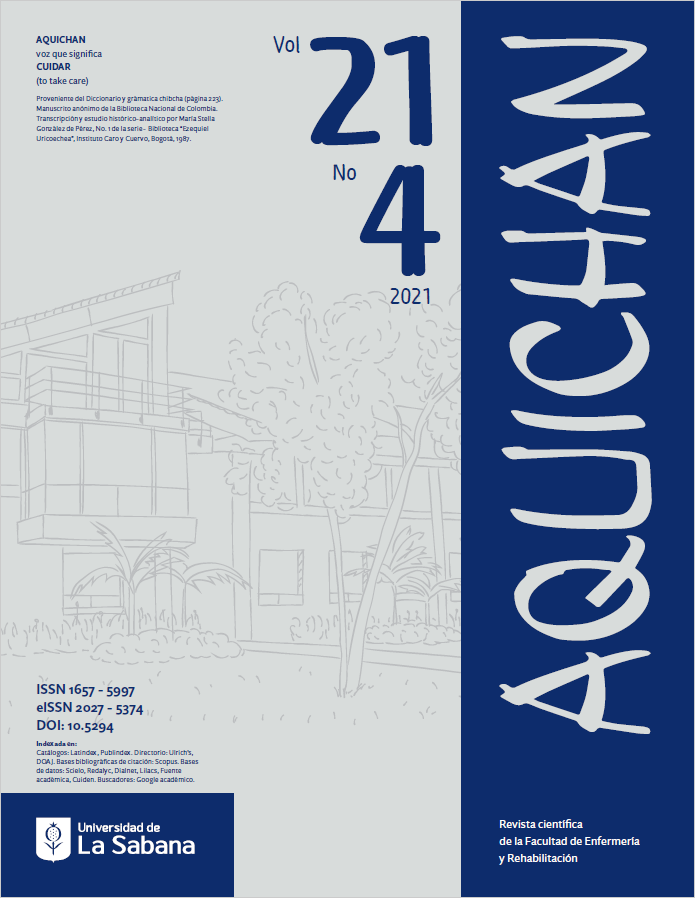Developing Mid-Range Theories for the Maturation of Nursing Care in Colombia
DOI:
https://doi.org/10.5294/aqui.2021.21.4.6Keywords:
Nursing theories, nursing care, knowledge development, research, nursingAbstract
Nursing theory has evolved since the 1960s, from conceptual models to concept analysis to mid-range theories. Mid-range theories are developed primarily for qualitative research, to target patient problems, to respond to patient needs, to identify interventions and the changing patterns of patient care. These mid-range theories cluster in various patterns to provide valid, coherent, and significant interventions. Examples of programs that have dramatically impacted our understanding of nursing and patient care are presented. Thus, by developing and implementing the findings of mid-range theories, nursing care matures, and the standards advance.
Downloads
References
Denyes MJ, Orem DE, Bekel G. Self-care: A foundational science. Nurs Sci Q. 2001;14(1):48-54. DOI: https://doi.org/10.1177/089431840101400113
Roy C. Research based on the Roy adaptation model: Last 25 years. Nurs Sci Q. 2011;24(4):312-20. DOI: https://doi.org/10.1177/0894318411419218
Fawcett J, DeSanoto-Madeya S. Contemporary Nursing Knowledge: Analysis and evaluation of nursing models and theories. 3rd ed. Philadelphia: F. A. Davis; 2013.
Fawcett J. Middle range nursing theories are necessary for the advancement of the discipline. Aquichan. 2005;5(1):32-43. Available from https://aquichan.unisabana.edu.co/index.php/aquichan/article/view/57
Fawcett J. Using the Roy adaptation model to guide research and/or practice: construction of Conceptual-Theoretical-Empirical systems of knowledge. Aquichan. 2009;9(3):297-306. Available from: https://aquichan.unisabana.edu.co/index.php/aquichan/article/view/1527
Morse JM. Analyzing and Conceptualizing the Theoretical Basis of Nursing. New York: Springer; 2017. DOI: https://doi.org/10.1891/9780826161024
Bottorff JL. The use and meaning of touch in caring for patients with cancer. Oncol Nurs Forum. 1993;20(10):1531-1538. Available from: https://pubmed.ncbi.nlm.nih.gov/8278279/
Penrod J, Morse JM, Wilson S. Comforting strategies used during nasogastric tube insertion. J Clin Nurs. 1999;8(1):31-8. DOI: https://doi.org/10.1046/j.1365-2702.1999.00229.x
Morse JM, Doberneck B. Delineating the concept of hope. J Nurs Scholarsh. 1995;27(4):277-85. DOI: https://doi.org/10.1111/j.1547-5069.1995.tb00888.x
Morse JM, Kent-Marvick J, Barry LA, Harvey J, Okang EN, Rudd EA, Wang CY, Williams MR. Developing the resilience framework for nursing and healthcare. Glob Qual Nurs Res. 2021;8:1-21. DOI: https://doi.org/10.1177/23333936211005475
Vann-Ward T, Morse JM, Charmaz K. Preserving self: Theorizing the social and psychological processes of living with Parkinson disease. Qual Health Res. 2017;27(7):964-82. DOI: https://doi.org/10.1177/1049732317707494
Morse JM. Toward Understanding Comfort and Comforting. In Analyzing and Conceptualizing the Theoretical Basis of Nursing. New York: Springer; 2017.
Wuest J, Ford-Gilboe M, Merritt-Gray M, Berman H. Intrusion: the central problem for family health promotion among children and single mothers after leaving an abusive partner. Qual Health Res.2003;13(5):597–622. DOI: https://doi.org/10.1177/1049732303013005002
Ford-Gilboe M, Wuest J, Merritt-Gray M. Strengthening capacity to limit intrusion: Theorizing family health promotion in the aftermath of woman abuse. Qual Health Res. 2005;15(4):477-501. DOI: https://doi.org/10.1177/1049732305274590
Ford-Gilboe M, Wuest J, Varcoe C, Davies L, Merritt-Gray M, Hammerton J, Wilk P, Campbell J. Modelling the effects of intimate partner violence and access to resources on women’s health in the early years after leaving an abusive partner. Soc Sci Med. 2009;68(6):1021-1029. DOI: https://doi.org/10.1016/j.socscimed.2009.01.003
Scott-Storey KA, Hodgins M, Wuest J. Modeling lifetime abuse and cardiovascular disease risk among women. BMC Cardiovasc Disord. 2019 Dec;19(1):1-4. DOI: https://doi.org/10.1186/s12872-019-1196-y
Ford-Gilboe M, Merritt-Gray M, Varcoe C, Wuest J. A theory-based primary health care intervention for women who have left abusive partners. ANS Adv Nurs Sci. 2011;34(3):198–214. DOI: https://doi.org/10.1097/ANS.0b013e3182228cdc
Wuest J, Ford-Gilboe M, Merritt-Gray M, Varcoe C. Exemplar: Building on “Grab,” Attending to “Fit,” and Being Prepared to “Modify”: How Grounded Theory “Works” to Guide a Health Intervention for Abused Women. In: Morse JM, Bowers BJ, Charmaz K, Clarke AE, Corbin J, Porr CJ, Noerager Stern P, editors. Developing Grounded Theory. NY: Routledge; 2021. p.90-107. DOI: https://doi.org/10.4324/9781315169170-8
Wuest J, Merritt-Gray M, Dubé N, Hodgins M, Malcolm J, Majerovich J, Scott-Storey K, Ford-Gilboe M, Varcoe C. The process, outcomes, and challenges of feasibility studies conducted in partnership with stakeholders; A health intervention for women survivors of intimate partner violence. Res Nurs Health. 2015;38(1):82-96. DOI: https://doi.org/10.1002/nur.21636
Ford-Gilboe M. iHEAL Trial: Effectiveness of a health promotion intervention for women who have experienced intimate partner violence. U.S. National Library of Medicine; 2021. Available from: https://clinicaltrials.gov/ct2/show/NCT03573778
Beck CT. Middle range theory of traumatic childbirth: The ever-widening ripple effect. Glob Qual Nurs Res. 2015. DOI: https://doi.org/10.1177/2333393615575313
Morse JM. Theoretical coalescence: a method to develop qualitative theory: the example of enduring. Nurs Res. 2018;67(2):177-187. DOI: https://doi.org/10.1097/NNR.0000000000000263
Dickoff J, James P. A theory of theories: A position paper. Nurs Res. 1968;17(3):197-203. DOI: https://doi.org/10.1097/00006199-196805000-00004
Fawcett J. Tendencias de investigación en enfermería. Aquichan. 2014;14(3):289-93. DOI: https://doi.org/10.5294/aqui.2014.14.3.1
Merton RK. On sociological theories of the middle range; 1949. Available from: http://www.csun.edu/~snk1966/Robert%20K%20Merton%20-%20On%20Sociological%20Theories%20of%20the%20Middle%20Range.pdf
Published
How to Cite
Issue
Section
License
Copyright (c) 2021 Aquichan

This work is licensed under a Creative Commons Attribution-NonCommercial-NoDerivatives 4.0 International License.
1. Proposed Policy for Journals That Offer Open Access
Authors who publish with this journal agree to the following terms:
- The journal and its papers are published with the Creative Commons License Attribution-NonCommercial-NoDerivatives 4.0 International (CC BY-NC-ND 4.0). You are free to share copy and redistribute the material in any medium or format if you: give appropriate credit, provide a link to the license, and indicate if changes were made; don’t use our material for commercial purposes; don’t remix, transform, or build upon the material.









